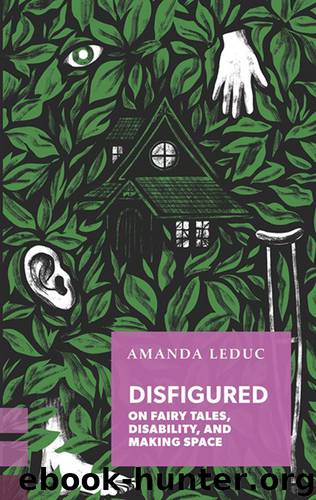Disfigured by Amanda Leduc

Author:Amanda Leduc
Language: eng
Format: epub
Publisher: Coach House Books
The skull, writes Dr. Humphreys in my medical notes in 1987, is of a pleasing shape and symmetry and with a circumference of 52 cm, the measurement is at about the 75th percentile. The ocular movements are full in all directions, except for the left lateral gaze, in which instance the left eye adopts a down and out posture. The fundi (bottom of the eye) are clear. There are no evidences of bulbar compromise.
What does it mean, exactly, for one’s skull to have a ‘pleasing shape’? Does he mean that it is nice to look at, in contrast to other skulls that aren’t? What makes a skull nice to look at?
‘Aesthetics,’ notes Siebers, ‘tracks the sensation that some bodies feel in the presence of other bodies … The human body is both the subject and object of aesthetic production: the body creates other bodies prized for their ability to change the emotions of their maker.’ Essentially, aesthetics – what we find beautiful and pleasing, and the opposite thereof – is about how we as human bodies relate to other bodies. We know and determine what is beautiful – and not beautiful – by placing it in relation to other things around it.
The word aesthetics comes to us from the Greek aisthetikos, which means ‘of sense perception.’ In Ancient Greece, the idea of beauty was firmly rooted in balance; Aristotle taught that art and artistic expression were ways of giving life to the essence of something – of unifying both the inner and outer parts of the objects that exist in the world. In his theory of mimesis, Aristotle speaks of the perfection of nature as a model for the true and the good; thus is balance and symmetry – that which accurately reflects both the inside perfection of something and its outer layer – sought out, while imbalance – that which indicates a flaw or other mark in a perfect design – is frowned upon. While nature is itself always changing, the Aristotelian idea of art and artistic expression is to imitate the world around us but also use mathematics and symmetry to replicate the perfect inherent in the unchanging, optimum state of nature.
Thus, beauty epitomizes balance, while that which is aesthetically shocking or displeasing indicates an imbalance that must be corrected. Tellingly, the Ancient Greeks also thought that in order for an object to be beautiful, it had to be useful as well. That which was both beautiful and of use espoused the highest good and the most use to society.
If something – or someone – is no longer useful, it cannot be truly beautiful; therefore, treatment of the affected object or individuals involves restoring balance and equilibrium so that utility, in turn, can once more be put in play. If something is not beautiful, it is no longer of use to society, or at the very least ceases to be regarded in the same favourable way as that which draws from us a positive aesthetic response.
The skull is of a pleasing shape and symmetry.
Download
This site does not store any files on its server. We only index and link to content provided by other sites. Please contact the content providers to delete copyright contents if any and email us, we'll remove relevant links or contents immediately.
| African-American Studies | Asian American Studies |
| Disabled | Ethnic Studies |
| Hispanic American Studies | LGBT |
| Minority Studies | Native American Studies |
Cecilia; Or, Memoirs of an Heiress — Volume 1 by Fanny Burney(31332)
Cecilia; Or, Memoirs of an Heiress — Volume 3 by Fanny Burney(30934)
Cecilia; Or, Memoirs of an Heiress — Volume 2 by Fanny Burney(30889)
The Great Music City by Andrea Baker(21313)
We're Going to Need More Wine by Gabrielle Union(18072)
Bombshells: Glamour Girls of a Lifetime by Sullivan Steve(13108)
Pimp by Iceberg Slim(12931)
All the Missing Girls by Megan Miranda(12747)
Fifty Shades Freed by E L James(12451)
Norse Mythology by Gaiman Neil(11883)
Talking to Strangers by Malcolm Gladwell(11876)
Crazy Rich Asians by Kevin Kwan(8349)
Mindhunter: Inside the FBI's Elite Serial Crime Unit by John E. Douglas & Mark Olshaker(7834)
The Lost Art of Listening by Michael P. Nichols(6472)
Enlightenment Now: The Case for Reason, Science, Humanism, and Progress by Steven Pinker(6405)
Bad Blood by John Carreyrou(5769)
The Four Agreements by Don Miguel Ruiz(5510)
Weapons of Math Destruction by Cathy O'Neil(5036)
We Need to Talk by Celeste Headlee(4868)
